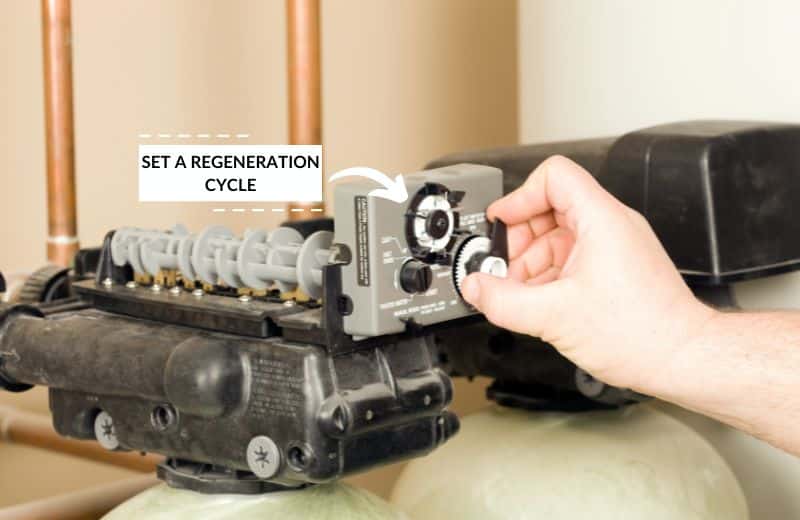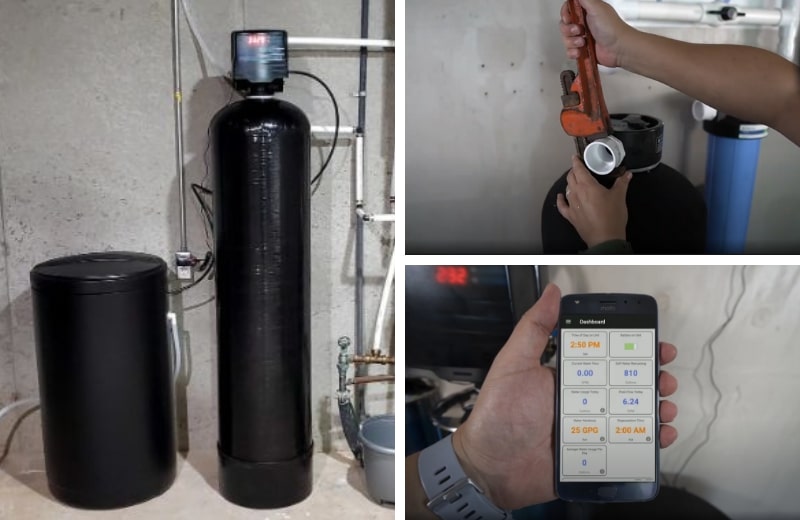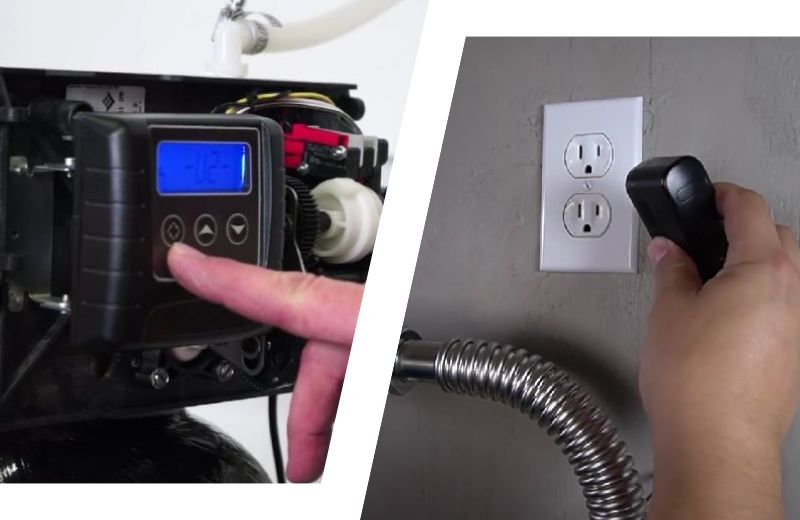Most water softeners let you schedule a time for the system to regenerate. For your water softener to regenerate at the right scheduled time, you need to set the timer in advance.
In this guide, we’ve shared a step-by-step on how to set your water softener timer.
📌 Key Takeaways:
- To set a water softener timer, use the indicator arrow or turn the dial to change the time settings.
- The timer controls the number of days between regeneration (how frequently more salt is drawn out of the brine tank) and the exact time of the day that regeneration occurs.
- You should set a softener timer to ensure the system consistently and effectively softens your water.
Table of Contents
⏱ How To Set A Water Softener Timer
Here’s how to set the timer on a water softener system.
There are two types of water softeners that use a timer:
- Digital water softeners – modern water softeners that can be operated digitally
- Analog water softeners – old water softeners that have analog controls
Let’s take a look at how to set the timer on each of these water softener types.
How To Set A Digital Water Softener Clock
Digital softening systems are generally the most advanced type of softeners available today, with a digital display screen that has a clock and shows how many gallons of water have been softened since the last the system last regenerated.
To set a water softener’s digital timer, follow these steps:
- Press and hold both arrow keys until the reading on the display shows “DO”, which stands for “Day Override”.
- You should see a number on the screen that dictates the water softener’s regeneration frequency. Use the arrow keys to alter the displayed days to change the frequency of regeneration cycles.
- Press the “Cycle” button to change this display to “RT”, or “Regeneration Time”, showing the time that the softener will regenerate.
- Here, the numbers on the screen will show the time of the day that your water softener is programmed to regenerate. If you want to change the time, use the arrows to do so.
How To Set An Analog Water Softener Timer
Analog softeners are conventional water softening systems that are going out of fashion in today’s market. However, they’re generally durable, long-lasting systems, and many people still own an analog water softener today.
Here’s how to set the timer on an analog water softening system:
- Locate the clock timer on your unit. It should be connected to the top of the system in a closed-off panel, held in place by several pins or clips.
- Remove the pins or clips and open the panel to access the clock.
- The clock will usually have a number of dials for you to alter. Start with the 24-hour clock dial, which dictates the time of regeneration. Rotate the dial to your preferred time.
- The other clock dial can be altered to determine how many days you want to leave between each time the softener performs a regeneration cycle. Move the dial to your preferred day setting.
💡 Tip: Don’t forget to check your water softener owners manuals for exact steps on how to set and change your timer. We’ve shared the steps for a typical water softener, but your own water softener’s instructions might be slightly different.
🤔 What Is A Water Softener Timer?
A water softener timer is found in a timer-controlled water softener.
The timer counts down a specific number of hours between water softener regenerations. You set the clock timer initially to program the softener to regenerate at certain times based on factors including your water hardness and water usage.
📌 Note: Demand-initiated water softeners do NOT have a timer. These systems regenerate after a specified amount of water has passed through the system, not after a specified amount of time.

💭 Why Set A Water Softener Timer?
You should set a water softener timer to keep your system performing at its peak.
Properly setting the timer in your water softener will ensure the regeneration process takes place as frequently as necessary.
There are a few occasions when you might need to set your water softener timer:
Initial Water Softener Setup
If you’ve just installed your water softener, setting the timer is one of the first initial setup tasks.
When you install the softener, it might have a few pre-set features, including timing for regenerations. However, your water softener might need to regenerate more or less frequently than the pre-set regeneration time, depending on your average daily water usage and water hardness.
In that case, you’ll probably need to change the initial setup to make sure the softener regenerates when needed.

To Change Regeneration Time
Perhaps the time that your water softener regenerates doesn’t suit you. If so, you might want to adjust the timer to choose a more suitable hour for regeneration.
Most water softener systems are set to regenerate at between 2am and 3am. The idea is that in the early hours of the morning, you’re least likely to need to use your water because you’ll be asleep. So if the water softener regenerates at this time, you won’t be bothered by the temporary lack of soft water.
However, if you’d prefer your water softener to regenerate at another time throughout the day, you can change it on the timer.
Water Softener Reset
Many electric water softener models reset themselves if they’re unplugged or switched off. If you’ve had a power outage, or your water softener was unplugged for any reason, you might need to re-input your programming, including regeneration timings.
It’s a good idea to make a note of your water softener’s timer settings in case the system ever resets and loses the information.

📆 How Often Should A Water Softener Regenerate?
The average water softener system regenerates once every 7-14 days.
The exact time between each regeneration cycle depends on the amount of water you use per day and your water hardness level.
The more water you use, the faster the resin beads will become saturated with calcium and magnesium minerals. Therefore, the more frequently the resin will need to be flushed and replenished with sodium ions (during the regeneration process).
The same goes for your water hardness. The harder your water, the more calcium and magnesium it contains, and the faster the resin becomes saturated with these minerals. That’s why water softeners have to regenerate more frequently when treating hard water compared to soft or moderately hard water.
📝 Final Word
Time-based water softening systems give you the freedom to decide on how often, and at what time, your water softener regenerates.
Being able to dictate exactly when a regeneration cycle occurs has its benefits – but we advise you to think carefully about your water hardness and water use before you set or alter a timer.
🧑🔧 Manually setting a water softener timer may result in the softener regenerating too frequently (and unnecessarily increasing your salt usage and wasting water as a result). Or, on the opposite end, it could cause the softener to regenerate too infrequently (so there isn’t enough salt in the resin bed to soften your water supply).
If you’re unsure how to set your regeneration settings based on your water use and hardness setting, check the owner’s manual or contact a professional plumber to get you set up.
❔ How to Set A Water Softener Time: FAQ
How does the timer work on a water softener?
The timer on a water softener usually displays two things: the regeneration frequency, and the time of the day that regeneration occurs. On timer-based softeners, you can change both these settings to suit your softening needs.
How often should I set my water softener to regenerate?
Generally speaking, you should set your water softener to regenerate every 7-14 days on average. Exact regeneration frequency depends on your water hardness setting (and therefore how much salt is used to soften your water) and your household size (again affecting the salt dosage). The higher your water hardness and the more water you use per day, the faster the resin will be depleted, and the more frequently the softener will need to regenerate.
Do you need to reset water softener timer after power outage?
If you have a digital softener, you might need to reset the clock settings on your water softener’s timer. Some softeners lose their settings after a power outage. If you don’t reset your softener, it could go back to pre-set commands, causing salty water to be drawn out of the brine tank too often or not enough. Make a note of your current settings in case you ever lose them in the future.

